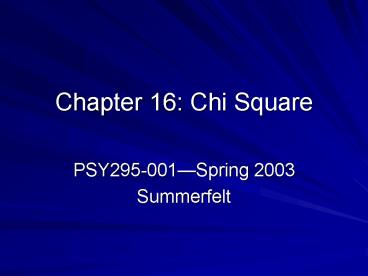Chapter 16: Chi Square - PowerPoint PPT Presentation
1 / 24
Title:
Chapter 16: Chi Square
Description:
Enter on following table. Chapter 16 Chi-Square. 10. Observed and Expected Freq. ... This is just the square root of the c 2 you would have with c 2 on those 4 cells. ... – PowerPoint PPT presentation
Number of Views:111
Avg rating:3.0/5.0
Title: Chapter 16: Chi Square
1
Chapter 16 Chi Square
- PSY295-001Spring 2003
- Summerfelt
2
Overview
- z, t, ANOVA, regression, correlation have
- Used at least one continuous variable
- Relied on underlying population parameters
- Been based on particular distributions
- Chi square (?2) is
- Based on categorical variables
- Non-parametric
- Distribution-free
3
Categorical Variables
- Generally the count of objects falling in each of
several categories. - Examples
- number of fraternity, sorority, and nonaffiliated
members of a class - number of students choosing answers 1, 2, 3, 4,
or 5 - Emphasis on frequency in each category
4
Contingency Tables
- Two independent variables
- Can be various levels similar to two-way ANOVA
- Gender identity, level of happiness
5
Intimacy and Depression
- Everitt Smith (1979)
- Asked depressed and non-depressed women about
intimacy with boyfriend/husband - Data on next slide
6
Data
7
What Do the Data Say?
- It looks as if depressed women are more likely to
report lack of intimacy. - What alternative explanations?
- Is the relationship reliably different from
chance? - Chi-square test
8
Chi-Square on Contingency Table
- The formula
- Expected frequencies
- E RT X CT GT
- RT Row total, CT Column total, GT Grand
total
9
Expected Frequencies
- E11 (37138)/419 12.19
- E12 (37281)/419 24.81
- E21 (382138)/419 125.81
- E22 (382281)/419 256.19
- Enter on following table
10
Observed and Expected Freq.
11
Degrees of Freedom
- For contingency table, df (R - 1)(C - 1)
- For our example this is (2 - 1)(2 - 1) 1
- Note that knowing any one cell and the marginal
totals, you could reconstruct all other cells.
12
Chi-Square Calculation
13
Conclusions
- Since 25.61 gt 3.84, reject H0
- Conclude that depression and intimacy are not
independent. - How one responds to satisfaction with intimacy
depends on whether they are depressed. - Could be depression--gtdissatisfaction, lack of
intimacy --gt depression, depressed people see
world as not meeting needs, etc.
14
Larger Contingency Tables
- Is addiction linked to childhood experimentation?
- Do adults who are, and are not, addicted to
substances (alcohol or drug) differ in childhood
categories of drug experimentation? - One variable adult addiction
- yes or no
- Other variable number of experimentation
categories (out of 4) as children - Tobacco, alcohol, marijuana/hashish, or
acid/cocaine/other
15
(No Transcript)
16
Chi-Square Calculation
17
Conclusions
- 29.62 gt 7.82
- Reject H0
- Conclude that adult addiction is related to
childhood experimentation - Increasing levels of childhood experimentation
are associated with greater levels of adult
addiction. - e.g. Approximately 10 of children not
experimenting later become addicted as adults.
Cont.
18
Conclusions--cont.
- Approximately 40 of highly experimenting
children are later addicted as adults. - These data suggest that childhood experimentation
may lead to adult addiction.
19
Tests on Proportions
- Proportions can be converted to frequencies, and
tested using c2. - Use a z test directly on the proportions if you
have two proportions - From last example
- 10 of nonabused children abused as adults
- 40 of abused children abused as adults
Cont.
20
Proportions--cont.
- There were 566 nonabused children and 30 heavily
abused children.
Cont.
21
Proportions--cont.
- z 5.17
- This is a standard z score.
- Therefore .05 (2-tailed) cutoff 1.96
- Reject null hypothesis that the population
proportions of abuse in both groups are equal. - This is just the square root of the c 2 you would
have with c 2 on those 4 cells.
22
Independent Observations
- We require that observations be independent.
- Only one score from each respondent
- Sum of frequencies must equal number of
respondents - If we dont have independence of observations,
test is not valid.
23
Small Expected Frequencies
- Assume O would be normally distributed around E
over many replications of experiment. - This could not happen if E is small.
- Rule of thumb E gt 5 in each cell
- Not firm rule
- Violated in earlier example, but probably not a
problem
Cont.
24
Expected Frequencies--cont.
- More of a problem in tables with few cells.
- Never have expected frequency of 0.
- Collapse adjacent cells if necessary.































